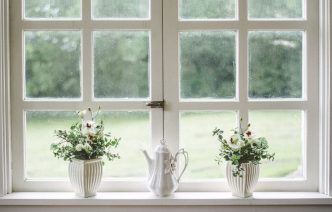Complete Guide to Bird-Watching From Your Window
Written by: Bill Herren
Bird-watching is a very rewarding hobby that can help you learn about your local wildlife. Bird-watchers use binoculars to seek out different species of birds and identify them based on size, color, shape, and feeding habits. They abide by a code of ethics that are in place to keep birds safe: It’s important that bird-watchers do not disturb habitats and remain unobtrusive when observing the behavior of birds. Keep reading to find out more about how to get started with bird-watching.
Choosing the Right Binoculars
Choosing the right binoculars is a very important part of successful bird-watching. The field of view should be wide enough to spot the bird and easily follow its movements. It’s also vital that the image is crystal-clear so you can see the bird’s distinguishing features. The binoculars must be able to focus quickly in order to provide a good view of the bird as it flies away and lands.
-
Choosing and Using Binoculars: The Cornell Lab of Ornithology has some tips to help a novice get the right binoculars for bird-watching.
-
Beginner’s Guide to Binoculars for Birding: Columbus Audubon details what a new birder needs to know before buying binoculars.
-
Choosing Binoculars for Birding: Advice about choosing the most useful binoculars for bird-watching can be found here.
Finding the Birds
There are a number of resources to help you locate the best places to go birding. Ebird.org has maps featuring bird hot spots and recent sightings posted by fellow birding enthusiasts. There are also graphs and interactive maps that will help you determine the best places to see certain species. Take a look to see if any good spots are near you.
-
Field Guides: Types of Birds: A list of field guides for different types of birds is found here.
-
All About Birds: Bird Guide: This database of popular birds will help you learn about their habits and where to go to find them.
-
The Kansas Wetlands Education Center: Bird-Watching: Birders in Kansas can visit the Cheyenne Bottoms Wildlife Area to see more than 340 species of birds.
-
A Guide to Bird-Watching and South Texas Wintering Birds (PDF): This guide to Texas bird-watching also has helpful information about bird identification.
-
Bird-Watching: Maps, Graphs, and Hot Spots: A wealth of information for learning about where to find certain species in the U.S. is contained on this site.
The Best Time to Bird-Watch
If you want to observe as many species as possible, it’s a great idea to go bird-watching at many different times throughout the day. Most birds are very active during the early morning, while early afternoon is a great time to spot hawks, falcons, and eagles. Late afternoon, evening, and nighttime is a great time to see many of the nocturnal species, like owls. The species you spot will vary depending on the season and your geographic area.
-
Wisconsin’s Beautiful Birds: The Best Time For Bird-Watching: This resource for Wisconsin bird-watching includes information about the best times of day to observe birds.
-
Bird is the Word: How to Begin Bird-Watching Like a Pro (PDF): Lots of information is provided here about where and when to go birding as well as what kind of gear is needed.
-
Bird Watching Helps Children Become Nature-Wise: Bird ID Basics, Supplies, and Watch Sites (PDF): This comprehensive article includes great information about where to find birds.
-
Bird-Watching Tips: Some birds are easiest to observe around sunrise and sunset, while others are easy to spot at any time of day.
-
The Top 250 Birding Spots in the U.S. and Canada: A list of excellent birding locations by state is found here.
Bird Identification
Learning to identify birds is fun and can be easy if you keep in mind the four keys of bird identification: size and shape, color pattern, behavior, and habitat. You can judge the size of new birds against birds you already know. After you’ve identified the size and shape, you can begin to observe what the bird eats, where it lives, and how it flies. Listening to the sounds the bird makes can also help to identify it.
-
Developing Your Observation Skills: Birds: Iowa State University offers tips on how to identify birds by their size, silhouette, plumage, beaks, and behavior.
-
Bird Identification Tips: A list of bird species is found here, along with tips about how they can be identified.
-
Visual Key for Bird Identification: This resource is helpfully divided by waterfowl, predatory birds, upland ground birds, tree-clinging birds, and more.
-
Bird Identification & Biology: This page features many helpful links for bird-watching and identification.
Birding Ethics
It’s vital that bird-watchers respect birds and nature while observing different species. The American Birding Association has published a code of birding ethics to be followed by all watchers. You can do your part to protect the welfare of birds by respecting their boundaries, moving slowly, staying on trails, and sitting or crouching down to appear smaller and less threatening.
-
The ABA Code of Ethics: Principles of Birding Ethics: The official American Birding Association’s Code of Ethics seeks to guide birders’ conduct.
-
Birding Ethics: Protecting the Welfare of Birds: Information about respecting wildlife and protecting habitats is found here.
-
New Jersey Audubon: Minding Our Ps and Qs: This page includes the Ten Commandments of Birding, a great way to remember how to respect birds and nature.
Birding Clubs
Many birding enthusiasts might enjoy joining a club to meet other like-minded people. Midwesterners can join the DuPage Birding Club, one of the biggest birding groups in Illinois. Birding Pal is another great resource; based on your location, you can easily connect with other bird-watchers and arrange a time to go birding together. You can also browse a list of local guides and find a professional to help you explore the area.
- Carolina Bird Club: The Carolina Bird Club is a great resource for birders in North or South Carolina.
- Birding Pal: Go Birding With a Pal Around the World: This site is a great resource with an opportunity to connect to other local bird-watchers.
- Bird Watcher’s Digest: Club Finder: Search for a bird-watching club in your area!
- The DuPage Birding Club: The DuPage Birding Club is one of the biggest clubs in the Midwest.
- The Biggest Week in American Birding: Northwest Ohio hosts a popular annual conference for birding enthusiasts.
| Wood Windows and Doors | Additional Window Options | Home Services |
|---|---|---|


